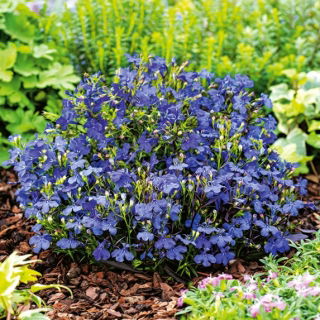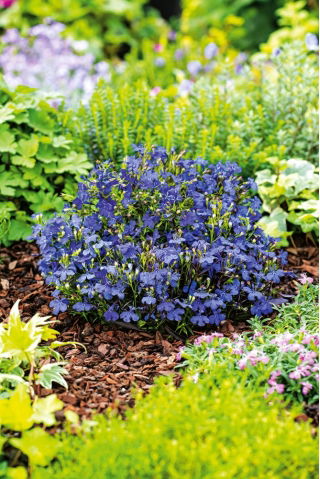Edging lobelia, known for its striking appearance, is an annual plant that will undoubtedly become a highlight of any garden. Its intensely blue, small flowers form compact, spherical clusters, ideal for planting in flower beds, borders, and containers. With a height ranging from 15 to 25 cm, Lobelia erinus brings harmony and colour to the garden. It is the perfect choice for those who appreciate aesthetics and the richness of nature.
Sowing
The Edging lobelia requires careful sowing to ensure optimal growing conditions. The seeds should be placed on the surface of well-prepared soil and gently pressed down to ensure contact with the substrate. It is important for the soil to be moist but not waterlogged, which supports germination.
Sowing Depth
Lobelia seeds should be sown at a depth of approximately 0.1 cm. Such shallow placement promotes quick germination and healthy growth. The optimal depth ensures access to light, which is crucial for the plant's proper development.
Sowing Period Under Cover
When to sow Edging lobelia seeds under cover? The best time is in March when light conditions and temperatures begin to improve. Sowing under cover allows for better control over climatic conditions, promoting early cultivation.
Planting Time
Planting Edging lobelia in May ensures that the plant has enough time to root and prepare for the flowering period. It is important to pay attention to weather conditions to avoid frost, which can harm young plants.
Plant Spacing
The appropriate spacing for Edging lobelia is 10x15 cm. This arrangement provides the plants with sufficient space to develop while allowing for the creation of dense, attractive clumps. Proper spacing ensures the plants have access to light and nutrients.
Companion Planting
Edging lobelia pairs beautifully with other ornamental plants such as petunias and begonias. Its intense colour contrasts beautifully with pastel shades, creating harmonious and attractive compositions. It is worth planting it near plants that prefer similar soil and light conditions.
Site Conditions
Edging lobelia thrives best in sunny or partially shaded spots. The optimal soil should be fertile, well-drained, and moderately moist. Regular watering is key, especially during dry periods, but it is important to avoid waterlogging, which can lead to root rot.
Growing Tips
Caring for Edging lobelia is not complicated. It requires regular watering and the removal of spent flowers, which encourages further blooming. It is also beneficial to feed it with mineral fertilisers to provide the necessary nutrients.
Plant Height
Edging lobelia reaches a height of 15 to 25 cm, making it ideal for low borders and containers. Its size makes it versatile and easy to combine with other plants.
Flowering Period
Edging lobelia blooms from June to October, allowing you to enjoy its beauty throughout the summer and into early autumn. Regularly removing spent flowers prolongs the flowering period and encourages the development of new blooms.
Usage
Edging lobelia is an excellent choice for ornamental flower beds, borders, or containers on terraces and balconies. Its unusual colour and compact form make it perfect for creating eye-catching compositions that will capture attention.
Resistance to Diseases
Edging lobelia is notable for its resistance to most plant diseases, although it is advisable to monitor for pests such as aphids. Regular inspections and proper care help prevent potential health issues.
Good to Know
Edging lobelia is not only beautiful but also relatively easy to grow. It is a plant that does not require intensive care, making it ideal for novice gardeners. It grows best in a temperate climate, where it is not exposed to extreme weather conditions.
Why Buy from Garden Seeds Market
Purchasing Edging lobelia seeds from Garden Seeds Market guarantees top quality and satisfaction. The seeds are carefully selected and tested in laboratories to ensure high germination capability. Additionally, fast delivery and satisfied customers attest to our professionalism. Garden Seeds Market is a place where every gardening enthusiast will find something suitable.
The package contains 0.2 g of seeds. The packaging includes information on cultivation guidelines and the sowing expiry date.



.jpg)
.jpg)
.jpg)


.jpg)
.jpg)
.jpg)

